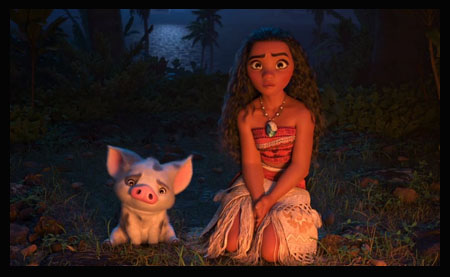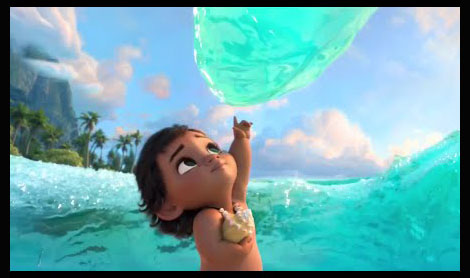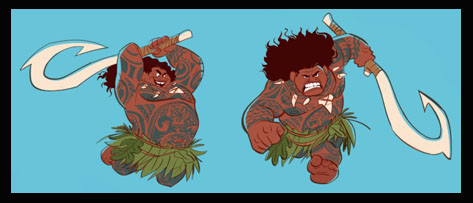
Disney’s new release, Moana, has been a long labor of love by the production team headed by directors Ron Clements and John Musker. The artistic braintrust behind The Little Mermaid, Aladdin, and Princess and the Frog brought together a group of passionate animators and artists to build the movie from the ground up. One of the most important of those artists is art director of characters on Moana, Bill Schwab.
Known inside Disney and by animators across the business as a great ringer who proves himself essential during the concept or visual development phase of production, Bill Schwab has been there during many a successful project. He won Annie Awards for his work on Prep and Landing and its sequel Naughty vs. Nice, developed characters for, among other films, Tangled, Wreck it Ralph and Frozen, (and was nominated for Annies for the latter two). He has worked with Ron and John before, on The Princess and the Frog. Talk with anyone in the industry who has worked with him, and they’ll place him among their favorites.
After so many of my friends in animation spoke of him in such glowing tones, I found myself very excited to meet him and discuss his experiences working on Moana. He did not disappoint. His enthusiasm is infectious, and his passion is inspiring. Read our Animation Scoop interview (below) to learn why he believes there’s a great future for animation, where traditional illustration and CG can work holistically to create artistic and classic films.

LC: One place where traditional hand-drawing is still of tremendous value is in concept work. Can you talk a bit about how you partner with 3D artists and how visual development has shifted?
BSchwab: I would say from a design perspective, the way I design on a hand drawn film vs a CG film, I’m designing the same way, unless it’s a dramatically graphic style which I already know could not be interpreted in 3D. In terms of the process of actually getting the film onscreen it’s quite different, and I love both parts of it a lot. I love the blank piece of paper “It could be anything” part of the process, and that challenge. It can be a wild and unpredictable adventure, but then I really love the collaboration with a team bringing a character on screen, because the way I approach it personally is that I feel like the drawing becomes the inspiration and the model is now our design. I really treat it that way. I feel like we chase down the drawing to a certain point, but then crafting that model, the rig, and the look development, and every aspect of what becomes the character that’s in the movie in a CG film, really becomes the design of the character.
We have what we call character teams at Disney where it is very much an ownership process with the whole team, so we really kind of hold hands and work together. So that includes the animation supervisor, the rigger, look development artist, modeler, and myself. So even though I’m designing multiple characters on the film, I’m then the ‘art person’, as the art director of characters, that then follows each one of these characters with multiple teams all the way through even into shot production. The animation supervisor, the heads of animation on this film, asked me, which was a first for me, to actually sit in on dailies. Animators would send me their shots, and I would actually do draw-overs on the characters to help with their appeal, and to push poses. They also had Randy Haycock working doing draw-overs… and several of the supervisors are excellent artists themselves, and/or hand drawn animators too, so drawing is a huge part of the way we communicate. We have a software called MEANDER, which is a Disney proprietary software but a lot of us are basically onion-skinning shots, where we can go frame by frame and draw over various poses and expressions. For me a lot of it was early on, characters can go off model or maybe not quite look like themselves, and so the team, myself, and on Moana Malcon Pierce, animation supervisor, spent a lot of time trying to figure out why…what mouth shapes were better for her, what makes her feel like Moana? It’s a challenging but really fun process, because you do see the character take shape, and then you see a performance test, and you see this voice coming out of the character, and it’s amazing and awesome!
LC: Can you see the hands of each of those who work together on a character when you’re watching a test?
BSchwab: Oh yeah! I know every decision that’s been made. It’s interesting because sometimes we’ll go off course, and this has happened on every film I’ve worked on, where all of the sudden the character you’re working on doesn’t feel like your character anymore, and it’s almost like an archeological dig to go back through model iterations, rigging controls, through even the way her skin or her hair is looking, because everything changes your character a little bit, and sometimes you get to a place where “wow this doesn’t look like our character” so we have to ask ourselves why and figure that out. It’s a wild process and it’s always an adventure.

LC: Do you even discover something better by accident in that way?
BSchwab: Well, one thing we’re always doing is evaluating if it’s better or worse than before. One of the things in design that I’ve learned, and is very unpredictable, is knowing when to stop. You can continue painting over a painting over and over and mess it up. For example, with trying to capture the things that change and figuring out if they are improving the character. I know with Pua (the pig) we played around a lot with the size of his nose. John (Lasseter) gave us a note saying he felt his nose was too big and he couldn’t see Pua’s three quarter eye, because his eyes were so far apart and his nose was so big. So we had to kind of go back and play with that. A lot of times things happen in animation testing, where an animator will start to pose out the character and it will reveal things about the character you either like, or you don’t like, that you never would have seen in a more static pose or in a drawing. So we are constantly reevaluating and evaluating where we are, trying not to lose what’s great and also trying not to mess it up.
LC: In that way it’s great to have the 2D and 3D working together, because it seems like it would create something very holistic in nature.
BSchwab: It’s very holistic, and it’s the opposite of a hand off process, which has really been something that has been developing for me since I was on Prep and Landing. When I was on that, the character modeling supervisor came to me and said “I really want you to come with me on rounds, I want you to be involved. I want you to be part of our team”. This was amazing to me, because I’ve always loved sculpture, I love 3D, I sort of think in 3D when I draw. That was, for me, the beginning of that trust relationship where you are part of more than just the drawing. I think an advantage we had in Moana was quite a few of us in leadership roles, (head of characters and technical animation) Carlos Cabral and a lot of animation supervisors, we’d all worked together since Wreck it Ralph. We’d worked on Ralph and Frozen, so we’d gotten a lot of characters up and running over the years. I think there’s a lot of trust that’s built there. If I get a strong note from someone I trust, it’s all good. He or she knows what I can do, and vice versa, like “Hey! Maybe you should try this..” I think that’s unique to teams that have worked together on multiple films. There’s a real bonus to that, because they know each other’s work. They believe in each other and I think it shows onscreen.
LC: How do you feel about the continuity of Ron and John as a team, since they’ve worked together for so long and this was their first CG movie?
BSchwab: I think they have a very keen eye for design, and push that really hard. I felt that on both films I worked with them on (The Princess and the Frog and Moana) In animation, they like to push cartoony-ness, and not being an animator on the film, I still know that was something they pushed on, particularly on some of our broader characters: to really bring a hand-drawn aesthetic to how far we can push our rigs, and how far we can push that on our characters. Also, for their first CG film, they jumped right in and owned it. It was pretty seamless. I think they have a sensibility in their films that found its way into Moana. It has their personality and the things they bring to each of their films.
LC: Can you talk a bit about draw-overs and how that continues to be helpful in bringing together CGI and the 2D aesthetic?
BSchwab: In the modeling process, the initial process, the models will send me a turnaround of where the character model is, as they’ve interpreted our drawings. I’ll do draw-overs on that: maybe the cheek should do this, or the nose should be more like this, the eyes, or whatever, but in shot production, what I learned in this movie that I sort of knew but really learned because I was so much more involved, was even if you have a character where you’ve everything you possibly can to make them appealing all the time, and you have everything working perfectly, they still can not look like themselves. So drawing is a great communication tool, especially with the studio so rooted in hand drawn animation. Instead of saying something about how Moana’s leg isn’t the way you imagined in one shot, you just do a drawing.

LC: I think of what a difference the draw-overs made in bringing Tangled to life, and making Rapunzel so appealing. Glenn Keane’s work shows up, and really influences the look of the finished film.
BSchwab: Glenn drew over many shots and was very involved through using MEANDER, and I think that was the first time we used it, and he was able to communicate through drawings in the room and outside the animation dailies to really bring that hand-drawn aesthetic into CG.
LC: I see the same quality of believability and appeal in Moana. I’d posit that draw-overs have a huge influence on that. Your thoughts?
BSchwab: I think that certainly myself and the animation supervisors and the heads of animation really wanted to push the caricature on this film and maybe make it broader than we thought, and I think with Ron and John’s influence of a broader style of animation, you really feel it. Everything is still very believable and it’s still something audiences can connect to, but there’s a traditional feel to it.
LC: You mean with squash and stretch and other elements of 2D animation?
BSchwab: Yes. By caricature, I mean the way animation can do things that the real world can’t. Part of that too is how hard the rigging team and animation worked to make sure our characters could do those things. It was such a great partnership in getting where we all wanted to go.
LC: I can see the references and can relate a lot of qualities these characters have to recent classics. Like the ocean in Moana and the rug in Aladdin, and Moana’s hair, how it floats and moves like Ariel’s in The Little Mermaid. If I can see those things in a CG movie, what you guys are doing is working!
BSchwab: Yes, thanks! Those movies are touchstones!

LC: Can you talk a bit about some of the ways specifically you built the characters or solved design problems or enhanced the character designs in Moana?
BSchwab: For all that, I’d say Dwayne and the character of Maui is a great example. We hoped it would be Dwayne Johnson from early on in the production Maui is not a caricature of Dwayne, but we brought a lot of his expressions and mannerisms into the design and the animation of the character. For Moana, my office was covered with pictures from research trips of girls that the directors met, that people they got to know. With Moana, I really wanted her to feel very specific, like she could be from someplace where they might have actually run into her. Costuming also was a big part of the specificity.
On Moana, with the lead character, she’s an action heroine, so we wanted to make sure we could shoot her from any angle. She was going to be doing everything. In order to do that, she has to look appealing, and look like herself from every angle. So we spent an enormous amount of time on the model, and even drawing over the rig from every angle. Normally we might do a front and a profile…but Malken, the animation supervisor, drew over every rig pose, from every conceivable angle, to make sure she would hold up. I think that’s something you can see. You will really notice in the film that she always looks like herself. She always looks appealing: from low angles, from high angles, jumping, and running, and doing all these things, and that’s not by accident. That was a concerted effort, and I think it paid off. Also Maui’s anatomy was a huge initiative for us. I heard that we would have lots of people in the film with not much clothing on. For example, Maui is shirtless, one of my things that I did was I asked Karl Gnass to come to the studio. arl teaches anatomy and life drawing at the studio, and he teaches at the animation union, and he’s respected worldwide as one of the experts on anatomy. I asked him if he would come to the studio and look at our characters and look at our rigs where they were at the time, and actually do draw-overs, and so he did three sessions, one for Maui, one for Moana and one for Tala. We had the rigging team, the animation team, and the design team all in one room with Karl, and I’d say that was quite a jumpstart. He really felt good about what we had, but he really pushed us to go to the next level. He even said on Tangled that the technology to get to where we wanted to get to wasn’t there yet, and he was very complimentary of how the rigs are now, and how we can get to something that maybe people haven’t seen before. It was very collaborative with Karl*.
LC: You have both loved animation from childhood and you’ve gone to Pratt, a traditional art school. With so many new artists in school right now who want to get into visual development, what would you say to them as advice?
BSchwab: For someone going into character design, observation of people is very important, and not just life drawing but really paying attention to who people are. Think about their back story, try and dig deeper than the surface, because I feel like so much of what character concept is, is entertainment. So it’s finding what is the thing about a character that people will connect with, what’s going to make them believable, what’s going to make them entertaining? That’s not just making them cool looking. I think there’s something below the surface that hopefully great character designers tap into. A lot of times people ask how we make a character appealing. That’s a difficult question to answer. It’s not about pretty. It’s about believability, and I believe in design in balance. I feel like audiences, and people in general, know when something is in or out of balance. That goes across car design, and furniture design, and character design. Certain things feel right. I teach at CalArts and one thing I tell my students is to trust their instincts. Studios hire people for what their taste is. It’s not just being able to emulate someone else or being able to draw pretty pictures. They really want what you want and what you see and as an artist you have to believe in that and own it because ultimately that is what it’s about. It’s not only your drawings, it’s your ideas you bring to the table, and convincing other people those are great ideas.
Moana opens nationwide November 23rd.
*Karl Grass will be giving a workshop on storyboarding for TV and signing books at CTN this November 19th and 20th. Get information on that HERE.
- CREATING COCO: An interview with Pixar’s Jason Katz, Story Supervisor - November 22, 2017
- OPEN LETTER: Animation Insiders Demand a Change from Sexism and Harassment in the Animation Industry - October 19, 2017
- The Glorious Labor of LOVING VINCENT: An Interview with filmmakers Dorota Kobiela and Hugh Welchman - September 28, 2017


 November 14th, 2016
November 14th, 2016  Leslie Combemale
Leslie Combemale  Posted in
Posted in  Tags:
Tags: 







